Shenzhen Technology University (SZTU) has adhered to its running philosophy of “seeking truth and pursuing excellence” and made a lot of scientific and technological achievements that are creative and groundbreaking in 2022.
1. New generation of the electric formula racing car passed the mark of four seconds of 0-100 km/h acceleration. (College of Urban Transportation and Logistics)

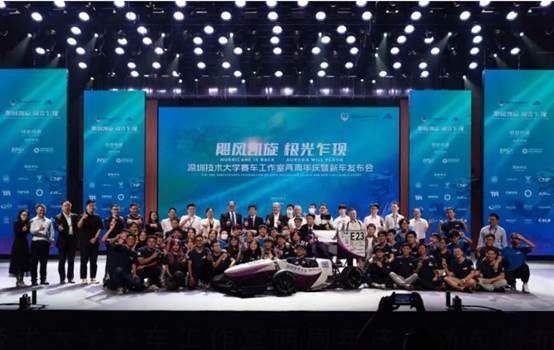
Racing Car Studio’s E24 racing car and the release conference [Photo/College of Urban Transportation and Logistics]
The E24 electric formula racing car designed by Racing Car Studio of SZTU adopted a four-motor drive system, which passed the mark of four seconds of 0-100 km/h acceleration. When the overall weight of the transmission structure is fixed, the system can greatly improve the stability of the racing car in the extreme driving state. In 2022, the team won the National Second Prize and Third Prize when participating in the Formula Student Electric China for the first time; and won the National First Prize and Second Prize in the 17th National University Students Smart Car Race (Outdoor).
Team leader: Li Heyan
Team members: 14 teachers and students including Wang Hongnan, Luo Jiezhong, Song Donghong, Li Meng, Gong Bian, Tian Mengjian, Mu Xiaolin, Yang Tao, Wu Jifeng, Zhang Zukai and Mai Haojun
2. Accurate and dexterous operation of robotics was achieved by the learning method of humanoid operation skills. (Sino-German College of Intelligent Manufacturing)
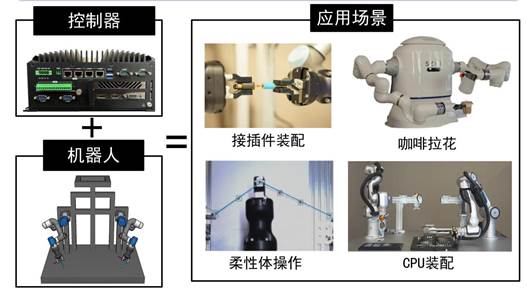
Controllers combined with robotics can be applied to different scenarios. [Photo/Sino-German College of Intelligent Manufacturing]
A new generation of intelligent robot controllers was developed with integrated algorithms including digital twin, intelligent perception, intelligent planning and intelligent control. The controllers can be combined with robots to automatically sort test tubes, make latte art, etc. They can make the robots deploy to different scenarios faster and easier.
Team leader: Ma Gan
Team members: 12 teachers and students including Zhu Zhikun, Huang Haojia, Zeng Linghui, Tang Zequan, Lin Zijia, Wang Boxiang, Long Fengxia, Xu Ziqi, Feng Han, Ye Han and Zheng Zhongpeng
3. Precise control of a large scale of drones was achieved based on HarmonyOS. (College of Big Data and Internet)
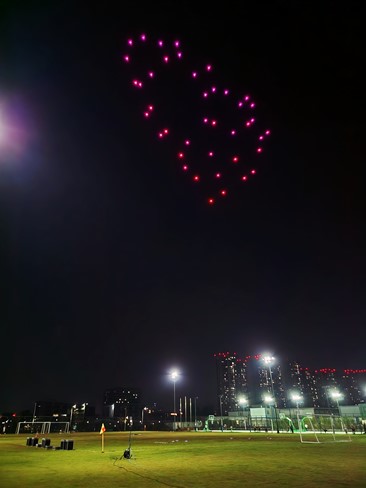
Drone performance [Photo/College of Big Data and Internet]
Distributed control governed by partial differential equations (PDEs) can ensure the stability of the UAV fleet performance and avoid collisions. A large scale of drones can be controlled by limited data interaction. The team can give full play to the advantages of domestic independent operating systems and have better control of more drones based on the drone performance plan using the open-source Harmony operating system.
Team leader: Li Meng
Team members: 15 teachers and students including Sun Ruize, Lin Lin, Shen Xiaole, Mei Fengcheng, Li Hongyu, Zhou Zijie, Deng Dongting and Lin Bolun
4. The generation and evolution mechanism of Turing patterns was found through physical methods for the first time. (College of New Materials and New Energies)
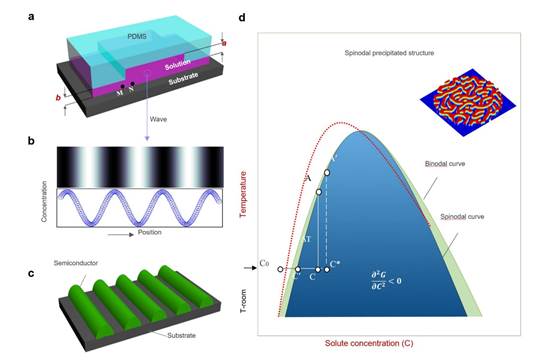
Schematic illustration of proposed concentration-wave formation process [Photo/College of New Materials and New Energies]
The research team found that Turing patterns can also be generated in an uphill-diffusion system without a chemical reaction process. The experimental system forms a simple dissipative structure that could generate patterns in natural conditions without artificial involvement and orderly and various patterns can be found in the biosystem. The research may pave a new way in developing self-assembling techniques of micro/nano structured materials and provide a new perspective for the understanding of biomorphic structures.
The work was published in Nature Communication (IF: 17.694) titled “Turing patterns with high-resolution formed without chemical reaction in thin-film solution of organic semiconductors”. The article can be found at: https://www.nature.com/articles/s41467-022-35162-z.
Team leader: Li Shunpu
Team members: Xiang Zezhong, You Peng, Han Linbo, Qiu Mingxia, Chen Gengliang, He Yu, Liang Songqiang, Xiang Boyuan, Su Yaorong, An Hongyu
5. A new regime of electron beam transport in solid-density plasma was identified. (College of Engineering Physics)

The supercomputing simulation lab at the Center for Advanced Material Diagnostic Technology [Photo/College of Engineering Physics]
SZTU researchers have studied the dynamics and evolution of the current filaments with their transverse dimension on the order of the skin depth ≪0.1 μm based on their three-dimensional particle-in-cell simulations. The research revealed the existence of a new regime of high-current electron beam transport in solid-density plasma, where the relativistic electron beams (REBs) can break up into nanoscale electron bunches by self-excited strong oscillating transverse electrostatic fields. Understanding such process underpins many novel applications of high-power lasers.
The findings were published in Physical Review Letters (IF:9.161) titled “Nanoscale Electrostatic Modulation of Mega-Ampere Electron Current in Solid-Density Plasmas”. The article can be found at: https://journals.aps.org/prl/pdf/10.1103/PhysRevLett.127.245002.
Team leader: Zhou Cangtao
Team members: Li Ran, Huang Taiwu, Ju Libao, Yu Mingyang, Zhang Hua, Wu Sizhong, Zhuo Hongbin
6. A fundamentally new strategy for ultrasensitive detection in the single biomolecular solution was demonstrated. (College of Integrated Circuits and Optoelectronic Chips)
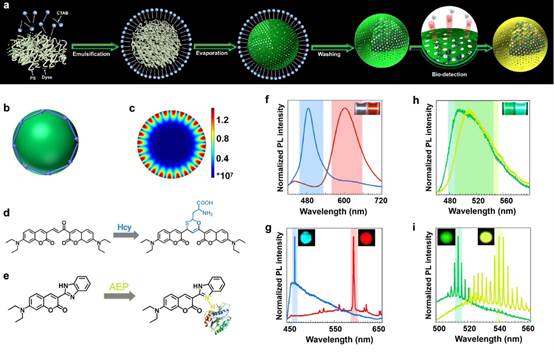
A fundamentally new strategy for ultrasensitive detection [Photo/College of Integrated Circuits and Optoelectronic Chips]
Researchers demonstrated a fundamentally new strategy for ultrasensitive detection based on color-switchable lasing with a cavity-enhanced reduction of limit of detection (LOD). The research proposed a novel ultrasensitive detection approach based on microsphere cavities formed by bio-compatible polystyrene (PS) mixed with dyes, penetrated by biomarker molecules when submerged in the biomolecular solution. When biomarkers interact with the chemo-responsive dyes, intramolecular charge-transfer modifies the electronic structure of dyes, resulting in the shift of emission wavelengths, thereby realizing qualitative detection of biomarkers with the naked eyes. The approach will offer exciting future opportunities for biomedical detection and early diagnostics to reduce the mortality rate of fatal diseases.
The research results were published in the interdisciplinary premium journal Advanced Science (Q1, IF: 16.806) titled “Ultrasensitive Detection of Biomarkers in a Color-Switchable Microcavity-Reactor Laser”. The full text of the paper can be found at: https://onlinelibrary.wiley.com/doi/10.1002/advs.202202326.
Team leaders: Ning Cunzheng, Ruan Shuangchen
Team members: Li Ran, Song Zongpeng, Zhu Haiou, Zhang Fanglin, Chen Lingling.
7. The first domestic precision milling and ultrafast laser equipment for producing dental repair materials were made. (College of Health Science and Environmental Engineering)
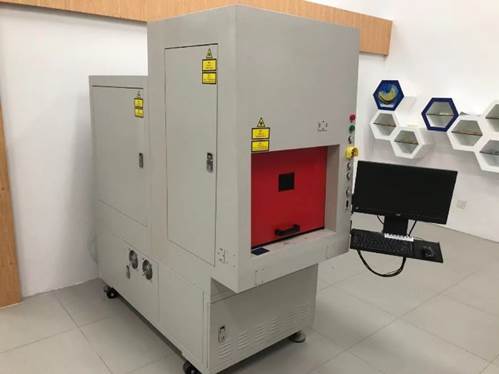
Precision milling and ultrafast laser equipment for producing dental repair materials [Photo/College of Health Science and Environmental Engineering]
This equipment can be used to process dental all-porcelain repair materials by using ultrafast laser and micro-nano processing technology and based on the five-axis motion control platform, which can solve the problems of large tool loss and low processing accuracy. With the comprehensive upgrade and application of high-power, high-frequency and ultra-short pulse laser technology, it will be prospective in industrialized manufacturing for dental health.
Team leader: He Zhengdi
Team members: Hu Peixin, Yao Lu, Huang Yiming.
8. The first non-isothermal precision glass molding technology based on graphene-like coating molds was created. (Sino-German College of Intelligent Manufacturing)
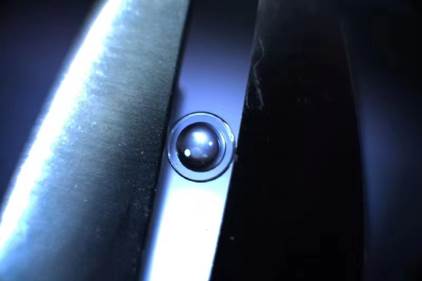
Non-isothermal precision glass molding technology based on graphene-like coating molds [Photo/Sino-German College of Intelligent Manufacturing]
The researchers developed the non-isothermal precision glass molding technology based on graphene-like coating molds which can be used to prepare precision glass optical components with non-spherical surfaces, free-form curved surfaces or others. Compared with traditional glass molding, it can lower the power, consuming time and cost, which is of great significance to the development of the precision optical industry. It will have broad applications in autonomous driving, medical testing, 3C industry, aerospace, marine surveying, military, etc.
Team leader: Li Lihua
Team members: 25 students including Qu Xiaofeng, Yu Ninghui, Yan Lingyun, Zhang Ziqi, Du Jiale, Chen Xiaoqi, Huang Wei, Deng Congren, Jiang Xiaotian and Zheng Donghao
9. A high-efficiency auxiliary decision-making system for scheduling urban rail traffic was developed. (College of Urban Transportation and Logistics)

The auxiliary decision-making system for scheduling urban rail traffic [Photo/College of Urban Transportation and Logistics]
The team developed an auxiliary decision-making system for scheduling urban rail traffic based on the existing operation and dispatching system. It can simulate the operational command and emergency treatment of trains under normal and abnormal conditions to better help complete urban rail transit operation tasks with high efficiency and high quality.
Team leader: Luo Qin
Team members: Li Wei, Mo Yihong, Liang Zi’an, Zhang Luowei
10. A new type of Chirped Fiber Bragg Grating (CFBG) writing scheme was developed. (Center for Advanced Material Diagnostic Technology)
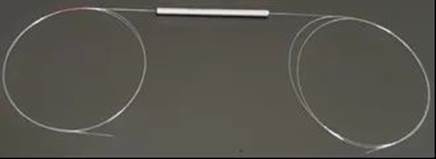
The dispersion management reflector [Photo/Center for Advanced Material Diagnostic Technology]
The research team has optimized the grating technology and manufacturing process and developed the CFBG writing system and it has been used on trial at more than ten scientific research institutes and enterprises including Institute of Physics of the Chinese Academy of Sciences (CAS), Xi’an Institute of Optics and Precision Mechanics of CAS, Beijing University of Technology, Han’s Laser and Huawei. The prepared dispersion management reflector enjoys great accuracy and consistency and receives good feedback.
Team leader: Guo Xiaoyang
Team members: Lin Qingdian, Yu Jun, Zhang Zhe
SZTU will strive towards bigger hi-tech achievements and make substantial progress in the new year of 2023!
Drafted by Daisy(姚琦)/ International Cooperation & Student Affairs Office
Revised by International Cooperation & Student Affairs Office
Edited by International Cooperation & Student Affairs Office
